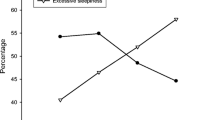Abstract
A major problem in the discussion of sleep-disordered breathing is caused by the use of different criteria to define its terms. Hypopnea is a good example of this: there is no consensus about its definition yet. In our study, the diagnosis value of apnea-hypopnea indexes (AHIs) determined by different hypopnea definitions was evaluated. The 90 patients who had an AHI> 5, scored according to the hypopnea definition of the American Academy of Sleep Medicine (AASM), participated in our study. The records of these patients were scored three times more according to different hypopnea definitions (hypopnea-arousal, hypopnea-desaturation, hypopnea-effort). AHIAASM, AHIarousal, AHIdesat, and AHIeffortwere determined via new scorings. Patients’ daytime sleepiness was evaluated by the Epworth Sleepiness Scale (> 10). When all of three major symptoms (snoring, observed apnea, and daytime sleepiness) were found in a patient’s history, the term “clinical OSAS” was applied. The Epworth value correlated with all of the indexes. In the scope of both the determination of daytime sleepiness and the verification of “clinical OSAS” diagnosis, the value AHIAASM= 5 had the highest sensitivity (100%) and specificity (94%).
Similar content being viewed by others
References
The Report of an American Academy of Sleep Medicine Task Force Sleep-related breathing disorders in adults: recommendations for syndrome definition and measurement techniques in clinical research. Sleep 1999;22:667–689
Guilleminault C, Tilkian A, Dement WC. The sleep apnea syndromes. Annu Rev Med 1976;27:465–484
Block AJ, Boysen PG, Wynne JW, Hunt LA. Sleep apnea, hypopnea and oxygen desaturation in normal subjects. N Engl J Med 1979;300:513–517
Moser NJ, Phillips BA, Berry DTR, Harbison L. What is hypopnea, anyway?. Chest 1994;105:426–428
Gould GA, Whyte KF, Rhind GB et al. The sleep hypopnea syndrome. Am Rev Respir Dis 1988;137:895–898
Guilleminault C, Sotoohs A, Clerk A, Cetel M, Maistros P. A cause of excessive daytime sleepiness. The upper airway resistance syndrome. Chest 1993;104:781–787
Hosselet JJ, Ayappa I, Norman RG, Krieger AC, Rapoport DM. Classification of sleep-disordered breathing. Am J Respir Crit Care Med 2001;163:398–405
Author information
Authors and Affiliations
Corresponding author
Rights and permissions
About this article
Cite this article
Ciftci, T.U., Kokturk, O. & Ozkan, S. Apnea-Hypopnea Indexes Calculated Using Different Hypopnea Definitions and Their Relation to Major Symptoms. Sleep Breath 8, 141–146 (2004). https://doi.org/10.1007/s11325-004-0141-0
Issue Date:
DOI: https://doi.org/10.1007/s11325-004-0141-0




